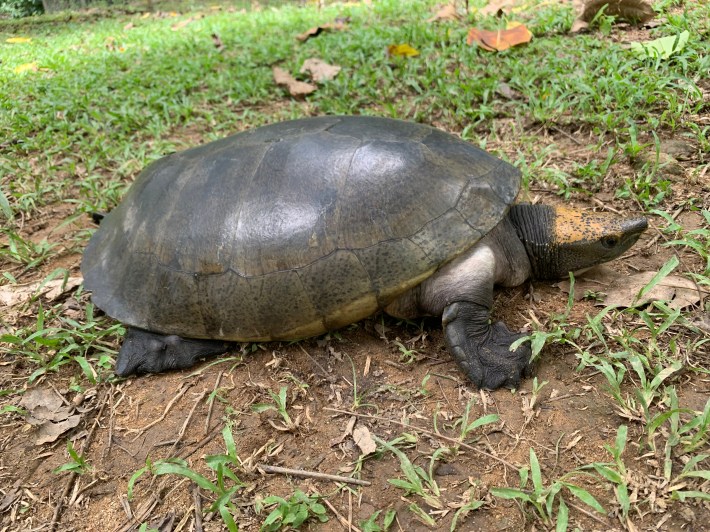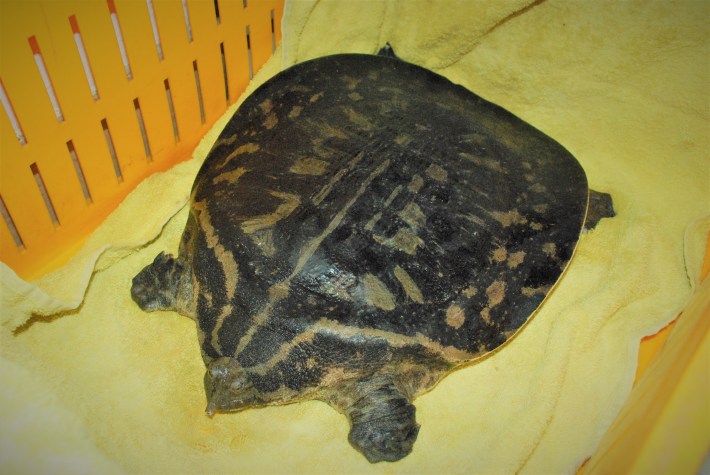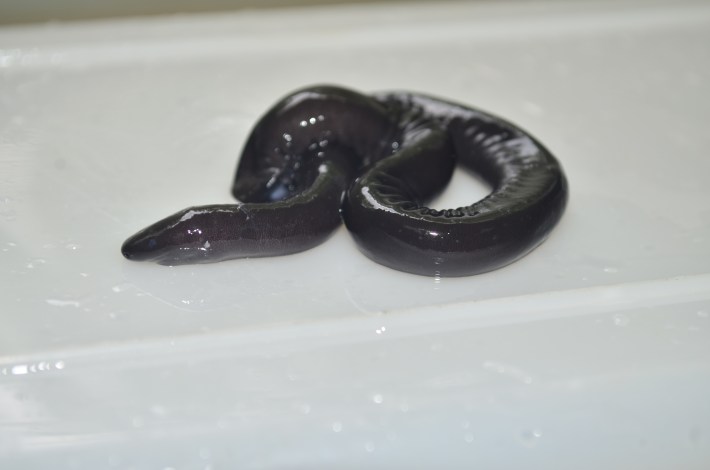More than a decade ago, when turtle specialist Camila Ferrara was just starting her PhD, she knew that she wanted to study sound communication in turtles. The concept surprised many of her supervisors, who asked Ferrara if she was sure this was a good idea. Some even suggested it could be a risk for her PhD. "They asked me, 'Are you sure you are going to work with sound communication? Because there are so many people who work with turtles, and they never talk about this. Nobody hears turtles,'" said Ferrara, who now works on freshwater turtle conservation for the Wildlife Conservation Society Brazil. "I said, no, I want to try."
Ferrara's supervisors had a point: very few people were talking about sound communication in turtles. But Ferrara had just encountered a paper by Jacqueline C Giles, a researcher in New Zealand. As far as Ferrara had read, Giles was the first person to describe sound communication in turtles, and proved that it happened in at least one species. When Ferrara thought about which species to record first, only one turtle came to mind: Podocnemis expansa, or the giant South American river turtle. "It's one of the most social species in the world," Ferrara said.
In October, a group of researchers that included Ferrara published a paper in Nature Communications finding that at least 50 species of turtles, as well as a few other cold-blooded species long dismissed as mute, do actually vocalize. The researchers recorded all of these species emitting a range of snuffles, grunts, snorts, and farts—in the acoustic sense. Not only do these results overturn the assumption that turtles are always silent, they also suggest that vocalizations can be traced back to a common ancestor about 407 million years ago.
Acoustic communication is not the same as language. The question of whether animals have language is an old and controversial one, although some recent studies suggest the communications of some species may well be called a language, according to a story in Hakai. We've learned, for instance, that great tits may have their own understanding of grammar, and that dolphins call each other by their own uniquely whistled name. Animals can also communicate acoustically with other parts of their bodies, such as a the rattling of a rattlesnake or the drumming of a macaque monkey. Regardless of how the sounds come, acoustic communication is a crucial form of communication among vertebrates—albeit one that leaves little trace of its occurrence.

In other words, to complete her PhD, Ferrara (and a microphone) had to venture into the Amazon, find the giant South American river turtles, and then listen to see if they were making sounds. The first year, she listened only to adults. The next, she listened to hatchlings. She eventually recorded the eggs too, and learned the turtles start to vocalize in an embryonic form. "We were so excited with what we had discovered. And then we started to ask ourselves, 'How about the other species?'"
Gabriel Jorgewich-Cohen, an evolutionary biologist at the University of Zurich and the lead author on the new paper, first learned about turtle talk through Ferrara's paper on the vocalizations of the giant South American river turtle. Intrigued, he went to the Amazon to do fieldwork with some of the authors of Ferrara's paper and heard the turtles vocalize for the first time. The experience reminded him of another time he'd heard tortoises vocalizing...
For a long time, research on turtles making sounds was focused on the grunts, roars, whimpers, wailings, and bellows the reptiles emitted during breeding. For example, the Malagasy radiated tortoise, mid-thrust, will emit a vocalization that sounds like "a nail being pulled from a board in two short jerks," one scientist wrote.
Although Jorgewich-Cohen had a pair of tortoises at home as well as a black-bellied slider turtle, he had not been lucky enough to hear their mounting-related melodies. But he remembered the day he brought his second tortoise home to meet the first tortoise, the two began moving their heads around and making "funny sounds that somehow sounded like chickens," he said. He started recording his black-bellied slider, too, putting a recording device in its tank for hours and then analyzing the resulting sounds—of which there were many.
Jorgewich-Cohen began an international tour of turtles, traveling to various institutions that had rare species in tanks. Some visits were as easy as dropping a microphone into a turtle tank and waiting for a few hours. Others proved more difficult, depending on the turtle. He visited Turtle Island in Graz, Austria, which houses two-thirds of all living species of turtles. "It's insane," he said. "I think it's the biggest collection of living turtles in the world." Turtle Island cares for several softshell turtles from New Guinea, a species called Pelochelys bibroni that can grow over a meter long. "They're fine, normally, but if you try to pick them up, they can become very aggressive," Jorgewich-Cohen said. "You don't want to get bitten by one, it feels like it could take your arm off." Instead, the keepers opted to remove every single other species of animal from the tank to isolate the hard-hearted softshells.
But the recording of the softshells was reward enough. "Probably the chattiest turtle I recorded," Jorgewich-Cohen said. "They don't have a diversity of sounds, but they won't stop producing sounds. All the time." Our own words, in any language, will always fall short of capturing animal sounds. But the researchers tried to approximate these noises with common words. "Turtles do a lot of clicking," Jorgewich-Cohen offered as an example.

Although the paper began with Jorgewich-Cohen listening to turtles from many families, he wanted to look at the bigger picture and see if other lineages of animals assumed to be mute or were otherwise less-studied might have have been chatting this whole time. "We knew this was bigger than we first thought," he said. So he decided to listen to tuataras, reptiles from New Zealand that look like lizards but are not lizards; caecilians, which are amphibians that look like snakes but are not snakes; and lungfish, which are lobe-finned fishes and our closest living fish relatives—take that, coelacanths!
Jorgewich-Cohen and his colleagues ended up collecting a huge diversity of sounds from the turtles and other creatures. When they played the sounds back to the zookeepers who cared for the animals, they were often impressed. But one sound stood out as being especially ridiculous. "The caecilian," he said. "When I first heard this, I sent it to one of my friends that was helping with field work at that time, and he was like, 'No, this is not true. You made this sound. You're joking with me.'" But it was no hoax. "The sounds from the caecilian really sounds like a, like a," Jorgewich-Cohen paused. "For lack of a better term, like a fart."

The researchers combined their new recordings with existing data on 1,800 other species thought to be vocal and nonvocal, then analyzed the probability of a common origin of sound back in evolutionary time. Much of this existing data was recently analyzed in a 2020 paper in Nature Communications, which slotted turtles into the "nonvocal group." John Wiens, a professor of ecology and evolutionary biology at the University of Arizona and an author of the 2020 paper, told Scientific American that a turtle making a sound does not necessarily mean it is communicating, and that Jorgewich-Cohen's new paper does not prove this.
Ferrara points out that acoustic communication would be particularly helpful for aquatic turtles, especially freshwater ones that live in murky rivers with low visibility. And Jorgewich-Cohen noted that the new paper couldn't focus on describing the repertoire of sounds from certain species. For example, the South American wood turtle Rhinoclemmys punctularia produced 30 distinct sounds. "I definitely cannot tell what all of them mean, but I kind of have a guess for some," Jorgewich-Cohen said.
Now that the record definitively shows turtles are absolute freaks for vocalization, the researchers are interested in investigating what, precisely, those vocalizations may mean. Jorgewich-Cohen wants to describe the entire acoustic repertoire of one of the species in the paper. Ferrara is still thinking about the giant South American river turtles, which make a range of sounds including one complex, hybrid sound. "It's like two sounds in one sound," Ferrara said. "We never expected to find this type of sound for turtles."
Ferrara now works in freshwater turtle conservation, work that is urgent given more than half of the world's turtles and tortoises are threatened by extinction, according to a 2020 paper in Current Biology. Their populations are rapidly declining for a number of reasons, including habitat loss and collection for the international pet trade. But whenever Ferrara goes out into the field for her job, if possible, she carries her sound equipment with her to see if she can record a new species or a new sound. It's easiest to find the giant South American river turtles, which gather in groups of thousands during breeding season, their innumerable heads breaking the surface of the river like foam. "When we think about turtles and not just about reptiles in general, we always say, 'Oh, they have a solitary behavior, they are very aggressive,'" Ferrara said. "We don't think about how they can be social."






